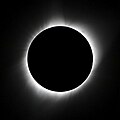Saros 108
This eclipse is a part of Saros series 108, repeating every 18 years, 11 days, and containing 76 events. The series started with a partial solar eclipse on January 4, 550 AD. It contains annular eclipses from May 13, 766 AD through December 4, 1108; hybrid eclipses from December 15, 1126 through January 28, 1199; and total eclipses from February 7, 1217 through August 11, 1523. The series ends at member 76 as a partial eclipse on April 8, 1902. Its eclipses are tabulated in three columns; every third eclipse in the same column is one exeligmos apart, so they all cast shadows over approximately the same parts of the Earth.
The longest duration of annularity was produced by member 13 at 3 minutes, 35 seconds on May 13, 766 AD, and the longest duration of totality was produced by member 46 at 5 minutes, 7 seconds on May 5, 1361. All eclipses in this series occur at the Moon’s descending node of orbit. [6]
| Series members 71–76 occur between 1801 and 1902: |
|---|
| 71 | 72 | 73 |
|---|

February 12, 1812 | 
February 23, 1830 | 
March 5, 1848 |
| 74 | 75 | 76 |
|---|

March 16, 1866 | 
March 27, 1884 | 
April 8, 1902 |
Tritos series
This eclipse is a part of a tritos cycle, repeating at alternating nodes every 135 synodic months (≈ 3986.63 days, or 11 years minus 1 month). Their appearance and longitude are irregular due to a lack of synchronization with the anomalistic month (period of perigee), but groupings of 3 tritos cycles (≈ 33 years minus 3 months) come close (≈ 434.044 anomalistic months), so eclipses are similar in these groupings.
The partial solar eclipses on April 8, 1902 (part of Saros 108) and January 5, 1935 (part of Saros 111) are also a part of this series but are not included in the table below.
| Series members between 2000 and 2200 |
|---|

July 1, 2000
(Saros 117) | 
June 1, 2011
(Saros 118) | 
April 30, 2022
(Saros 119) | 
March 30, 2033
(Saros 120) | 
February 28, 2044
(Saros 121) |

January 27, 2055
(Saros 122) | 
December 27, 2065
(Saros 123) | 
November 26, 2076
(Saros 124) | 
October 26, 2087
(Saros 125) | 
September 25, 2098
(Saros 126) |

August 26, 2109
(Saros 127) | 
July 25, 2120
(Saros 128) | 
June 25, 2131
(Saros 129) | 
May 25, 2142
(Saros 130) | 
April 23, 2153
(Saros 131) |

March 23, 2164
(Saros 132) | 
February 21, 2175
(Saros 133) | 
January 20, 2186
(Saros 134) | 
December 19, 2196
(Saros 135) |




























































